If the US Fish and Wildlife Service issues a press release, but no news outlet covers it (other than reprinting the release) is it news? The Endangered Species Act (ESA) guidance published in the Federal Register on Dec. 9 is news worth knowing for most state wildlife agencies.
(And likely, it’s not getting coverage because its being billed as a “policy draft.” But drafts quickly become policies, if no one is paying attention.)
The guidance aims to clarify the “significant portion of its range” phrase in the ESA. However, the language of the guidance seems to muddied the phrase’s meaning further.You’ve got to wonder when both the US Sportsmen’s Alliance (“continuing federal power grab”) and the Center for BioDiversity (“recipe for extinction”) are POed.
Thanks to the interpretation of the guidance by the Endangered Species Law and Policy blog of Nossaman LLP (yes, these are the lawyers who are suing your agency over wildlife and environmental issues, particularly if you are the State of California or the USFWS), it appears that:
-A species will now be protected throughout its range, even it is only at risk in one (“significant”) portion of its range. (This is what has the Sportsmen’s Alliance up in arms. Consider the impact on the Gunnison sage grouse, for example.)
-A species range will be considered only in its range now. Its historical range will be taken under consideration, but that’s all. (This is what has CBD up in arms. If a species is thriving in even a tiny portion of its vast former range, and wiped out in the rest, it won’t be considered at risk. Consider the impact on the gray wolf, for example.)
If you can’t get enough of this legal stuff, here’s a three-page interpretation of the guidance from Perkins Coie LLP, another law firm with an endangered species practice.
Read the USFWS press release here.
Read the guidance in the Federal Register here. (Be forewarned: It’s a 20 page PDF)
The US Fish and Wildlife Service and the National Oceanic and Atmospheric Administration (NOAA) are accepting public comment until February 7, 2012.
Photo: Gunnison sage grouse. Photo courtesy Bureau of Land Management

